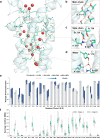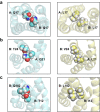Design of a water-soluble transmembrane receptor kinase with intact molecular function by QTY code
- PMID: 38858360
- PMCID: PMC11164701
- DOI: 10.1038/s41467-024-48513-9
Design of a water-soluble transmembrane receptor kinase with intact molecular function by QTY code
Abstract
Membrane proteins are critical to biological processes and central to life sciences and modern medicine. However, membrane proteins are notoriously challenging to study, mainly owing to difficulties dictated by their highly hydrophobic nature. Previously, we reported QTY code, which is a simple method for designing water-soluble membrane proteins. Here, we apply QTY code to a transmembrane receptor, histidine kinase CpxA, to render it completely water-soluble. The designed CpxAQTY exhibits expected biophysical properties and highly preserved native molecular function, including the activities of (i) autokinase, (ii) phosphotransferase, (iii) phosphatase, and (iv) signaling receptor, involving a water-solubilized transmembrane domain. We probe the principles underlying the balance of structural stability and activity in the water-solubilized transmembrane domain. Computational approaches suggest that an extensive and dynamic hydrogen-bond network introduced by QTY code and its flexibility may play an important role. Our successful functional preservation further substantiates the robustness and comprehensiveness of QTY code.
© 2024. The Author(s).
Conflict of interest statement
S.Z. is a member of board director of 511 Therapeutics that generates therapeutic monoclonal antibodies against solute carrier transporters. He is also a scientific advisor for OH2 Laboratories that works on generating therapeutic monoclonal antibodies against GPCRs. However, this study does not involve in GPCRs and solute carrier transporters. OH2 Laboratories licensed the QTY code technology from MIT. However, this article does not study GPCRs. S.Z. is the inventor of the QTY code and has a minor equity of OH2 Laboratories and majority equity in 511 Therapeutics shares that works on solute carrier transporters. S.Z. is also a scientific advisor for 3DMatrix Co Ltd, that commercializes self-assembling peptide hydrogels for surgical and accelerated wound-healing applications. MIT filed several patent applications for the QTY code for GPCRs and glucose transporters. The current study does not involve in GPCRs and glucose transporters. S.Z. is a co-founder and board director of Molecular Frontiers Foundation that encourages young people to ask good questions about science and nature and also organizes Molecular Frontiers Symposia around the world. There is no compensation for the activities. The remaining authors declare no competing interests.
Figures







Similar articles
-
Molecular Dynamic Simulations Reveal that Water-Soluble QTY-Variants of Glutamate Transporters EAA1, EAA2 and EAA3 Retain the Conformational Characteristics of Native Transporters.Pharm Res. 2024 Oct;41(10):1965-1977. doi: 10.1007/s11095-024-03769-0. Epub 2024 Sep 25. Pharm Res. 2024. PMID: 39322794 Free PMC article.
-
QTY code enables design of detergent-free chemokine receptors that retain ligand-binding activities.Proc Natl Acad Sci U S A. 2018 Sep 11;115(37):E8652-E8659. doi: 10.1073/pnas.1811031115. Epub 2018 Aug 28. Proc Natl Acad Sci U S A. 2018. PMID: 30154163 Free PMC article.
-
Structure Bioinformatics of Six Human Integral Transmembrane Enzymes and their AlphaFold3 Predicted Water-Soluble QTY Analogs: Insights into FACE1 and STEA4 Binding Mechanisms.Pharm Res. 2025 Feb;42(2):291-305. doi: 10.1007/s11095-025-03822-6. Epub 2025 Feb 18. Pharm Res. 2025. PMID: 39966220 Free PMC article.
-
Membrane proteins: always an insoluble problem?Biochem Soc Trans. 2016 Jun 15;44(3):790-5. doi: 10.1042/BST20160025. Biochem Soc Trans. 2016. PMID: 27284043 Free PMC article. Review.
-
Signal Sensing and Transduction by Histidine Kinases as Unveiled through Studies on a Temperature Sensor.Acc Chem Res. 2017 Jun 20;50(6):1359-1366. doi: 10.1021/acs.accounts.6b00593. Epub 2017 May 5. Acc Chem Res. 2017. PMID: 28475313 Review.
Cited by
-
Molecular Dynamic Simulations Reveal that Water-Soluble QTY-Variants of Glutamate Transporters EAA1, EAA2 and EAA3 Retain the Conformational Characteristics of Native Transporters.Pharm Res. 2024 Oct;41(10):1965-1977. doi: 10.1007/s11095-024-03769-0. Epub 2024 Sep 25. Pharm Res. 2024. PMID: 39322794 Free PMC article.
-
Molecular Identification and Functional Characterization of LC-PUFA Biosynthesis Elongase (elovl2) Gene in Chinese Sturgeon (Acipenser sinensis).Animals (Basel). 2024 Aug 14;14(16):2343. doi: 10.3390/ani14162343. Animals (Basel). 2024. PMID: 39199889 Free PMC article.
-
Discovery, design, and engineering of enzymes based on molecular retrobiosynthesis.mLife. 2025 Mar 28;4(2):107-125. doi: 10.1002/mlf2.70009. eCollection 2025 Apr. mLife. 2025. PMID: 40313979 Free PMC article. Review.
-
Structural bioinformatic study of six human olfactory receptors and their AlphaFold3 predicted water-soluble QTY variants and OR1A2 with an odorant octanoate and TAAR9 with spermidine.QRB Discov. 2024 Dec 9;6:e2. doi: 10.1017/qrd.2024.18. eCollection 2025. QRB Discov. 2024. PMID: 39944883 Free PMC article.
-
A structural and functional bioinformatics study of QTY-designed retinylidene proteins.QRB Discov. 2025 Jul 14;6:e20. doi: 10.1017/qrd.2025.10009. eCollection 2025. QRB Discov. 2025. PMID: 40838111 Free PMC article.
References
MeSH terms
Substances
Grants and funding
LinkOut - more resources
Full Text Sources

